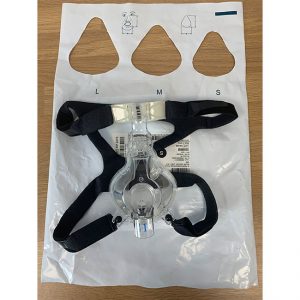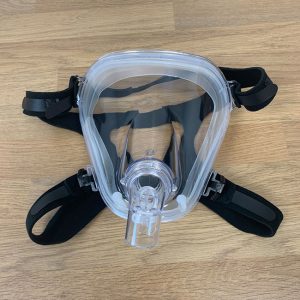Mask types
Nasal mask
- Not appropriate for Covid CPAP as we are unable to attach a second filter to the circuit.
Oro-nasal mask
- Comes in Small, Medium and Large
- Useful for mouth breathers
- Often offer a better fit with a smaller leak

Full face mask
- Comes in Small, Large and Extra Large
- Non-compliance with (oro-nasal mask)
- Rapid application
- Lack of teeth/Are dentures secure in the mouth?
- Facial abnormalities
- Can be more claustraphobic for patient
- Leak is often higher with this mask

Monitoring
Hourly patient monitoring:
- Respiratory rate: Monitor this through the CPAP machine as it is more accurate that the cardiac monitor
- Heart rate
- Blood pressure
- Temperature
- SpO2
- The amount of oxygen the patient is on
- Leak
- Expired Tidal Volume
- Peak Inspiratory Pressure
- Accessory Muscle use
- Patient repositioning
- Fluid chart: Intake and output
Proning
Instructions for patients
- Try not to spend a lot of time lying flat on your back.
- Lying on your stomach and in different positions will aid your body to get air into all the areas of your lungs.
- You are recommended to change your position every 30 minutes to 2 hours rotating your body into different positions as described below.
How to change position
- 1. Lie face down in the prone position with the bed flat (for 30 mins to 2 hrs).
- 2. Rotate to lie on your right side with the bed flat (for 30 mins to 2 hrs).
- 3. Adjust the bed to a sitting position (30-60 degrees) then sit in this supported position (for 30mins to 2 hrs).
- 4. Lower the bed to flat and lie on your left side (for 30 mins to 2 hrs).
- 5. Return to lie face down in the prone position with the bed flat (for 30 mins to 2 hrs).
Machine alarms and what they mean
These alarms should always be set for each patient.
Aponea alarm
- Set at 10-60 seconds, suggested settings are 10/20 seconds
DO NOT TURN OFF THIS ALARM
High/low VTE
- High – around 800 but depends on patients ideal weight
- Low – around 200 but depends on patients ideal weight
High/low Respiratory rate
- High – set at 10-15 breaths per minute above patients measured breathing
- Low – set at 10-15 breaths per minute below the patients breathing rate
Circuit disconnect
- Set at 0-15 seconds to allow for occasional excessive leaks
Nursing
Steroid Immunosuppression
Steroids should be considered standard of care and immediately started in cases that meet hospital admission criteria, usually Severe COVID Pneumonitis.
There is body of evidence to support its use in cases showing early ARDS, septic shock and confers mortality benefit.
What: Dexamethasone 6mg PO/IV once daily (with STAT dose); or
Prednisolone 40mg PO once daily; or
Hydrocortisone 50mg IV three times daily.
Administration: Oral (PO) is the preferred route, intravenous (IV) only when preferred route is not available.
Duration: 10 days.
Cautions
Already using long-term steroids?
Where patients are already on steroids (usually prednisolone) it is reasonable to convert to dexamethasone, but remember to return back to maintenance dose after 10 days.
Hyperglycemia
Steroid induced raised blood sugars are a consequence of high dose steroid use. It does not imply diabetes, although diabetic patients are at greater risk of elevated blood sugar measurement.
It is crucial to monitor and manage excessive blood sugar concentrations.
Each trust has developed guidelines for Hyperglycemia in COVID Steroid administration, please refer to you own trust guidelines for more information.


